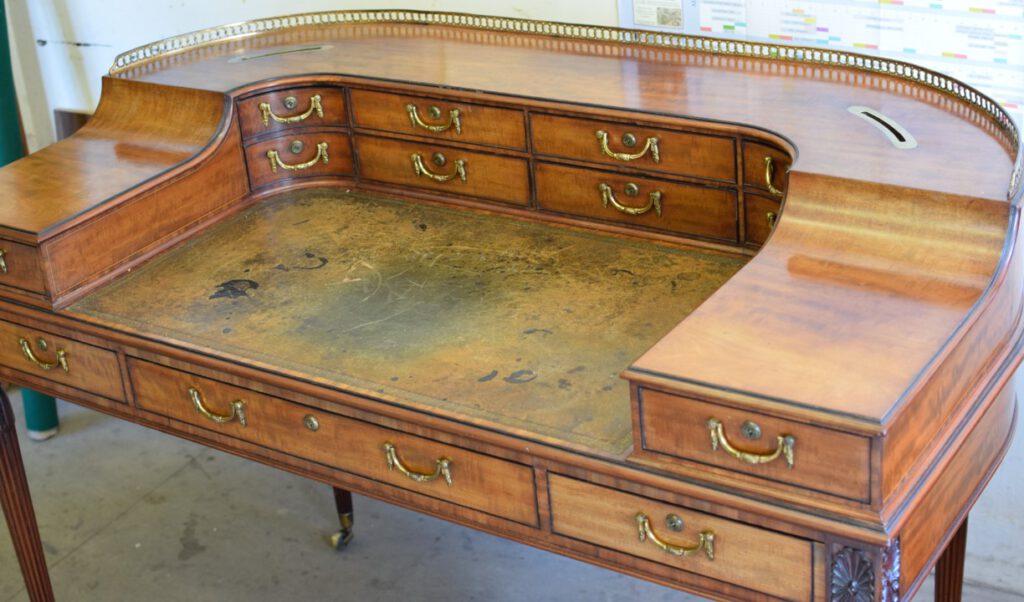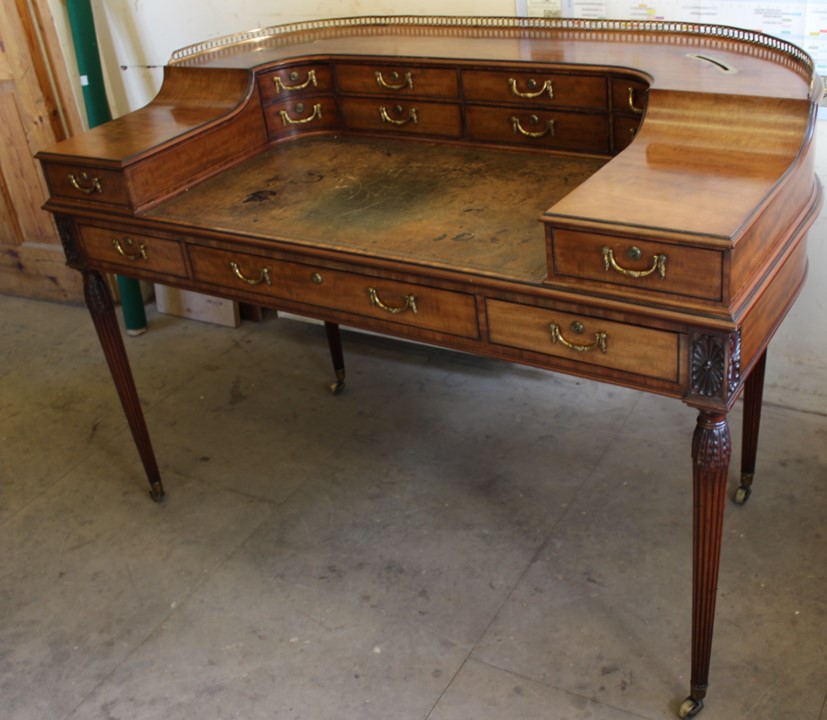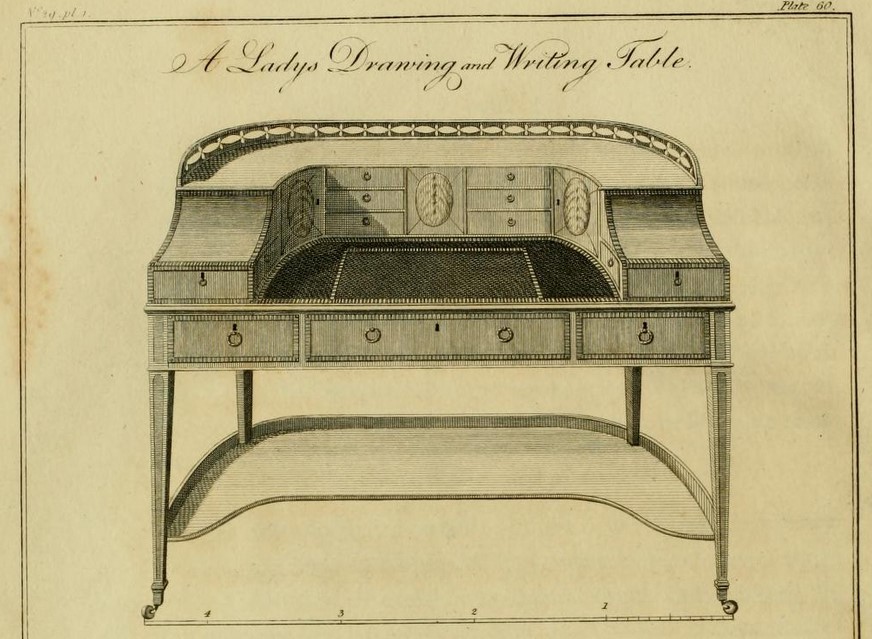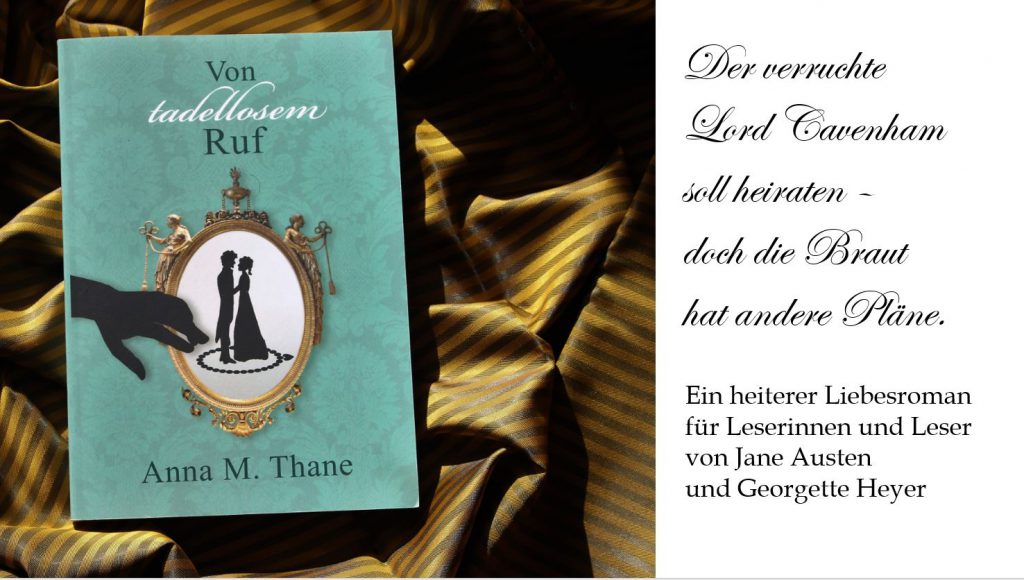
Simply by its alluding name the Carlton House desk immediately catches the attention of a Regency Enthusiast. The imagination produces an exquisite piece of furniture made of exotic woods, rich in ornaments, and designed for no less a person than the Prince Regent. Though some antique dealers like to dwell on this lovely image, it is but a half-truth.
The Desk
The Carlton House desk is a writing table with a central small cupboard and lots of fitted small drawers above the surface forming a “U” shape at the back. A brass rim, or gallery, runs around the outer edge of the superstructure. The desk stands on tapering legs, often with a spade foot. Some desks also had intricate painted local scenes and luxurious inlays as decoration. Woods used for the desk were fine timbers like Satinwood or Mahogany from the East and West Indies (pointing to deforestation and slave work in the supply chain).
The Carlton House desk was most popular in the Regency era but continued to be fashionable throughout the Victorian and Edwardian periods. It was an expensive piece of furniture, thus mainly ordered by the very wealthy.
The Legend
The Carlton House Desk is supposed to have been designed in the 18th century for the Prince of Wales (later George IV) by George Hepplewhite. It is named after Carlton House, which was the London residence of the Prince.

The Facts
The Carlton House Desk was produced from at least 1780. George Hepplewhite (died in 1786) is often credited with making the first one.
Little is known of George Hepplewhite’s life. He was apprenticed to the furniture maker Robert Gillow of Lancaster, and then went to London, and opened a shop on Redcross Street. There is only one evidence to show that Hepplewhite’s was a fashionable firm: He noted on a chair design that it had been “executed with good effect for the Prince of Wales”. Unfortunately, the royal accounts have no record of the chair.
George Hepplewhite doesn’t seem to have mentioned the Carlton House desk. Drawings of the desk were said to be presented by Alice Hepplewhite in a design book published two years after her husband’s death (“The Cabinet-Maker and Upholsterer’s Guide”.) The publicly accessible edition published in 1897 does not include the desk.
A desk looking like the Carlton House desk can be found in Thomas Sheraton’s “The Cabinet Maker and Upholsterer’s Drawing Book” (1802). Yet, the desk is called a ‘Ladies drawing and writing table’.

There is a writing desk in the approximate shape of a Carlton House desk made of rosewood in the Royal Collection, but it has a flat rather than stepped superstructure. Besides this desk, there is an account of a desk referred to as a ‘large elegant Satin wood writing table containing 15 drawers and 2 cupboards‘ preserved in the Royal Archive. It might have been a Carlton House desk. The piece has been identified as a desk given by the Prince of Wales to his acting private secretary Captain John Payne for his services in accompanying the Prince’s wife Caroline of Brunswick to England in 1795.
The name Carlton House desk first appeared in 1796,
in a cost book for clients of furniture makers Gillows.

The Conclusion
The Carlton House desk, typical for the Regency period, is a beautiful piece of furniture, but it has little to do with The Prince of Wales or his town residence. It seems to me that the description ‘Carlton House Desk’ was used for marketing reasons from the late 1790ies. The desk was an exquisite piece, and it spread into the studies and drawing rooms of nobility. The name Carlton House desk probably boosted production figures.
Trivia
There is a Carlton House desk in the Downton Abbey-series. It is located in the Main Library, and Lord Grantham and Matthew Crawley both sit at it and write on it in several scenes. The desk is part of the antiques of Highclere Castle. It was made ca. 1780.
A Carlton House desk dated to 1790 was auctioned by Christie’s in 2008 for approximately $60,000.

Sources
https://antiquesworld.co.uk/antique-carlton-house-desks/
https://www.britannica.com/biography/George-Hepplewhite
https://www.bonhams.com/auctions/21214/lot/85/
http://www.go-star.com/antiquing/famous-antiques0513.htm
Related articles
Article by Anna M. Thane, author of the novel
“Von tadellosem Ruf” (http://amzn.to/2TXvrez)

